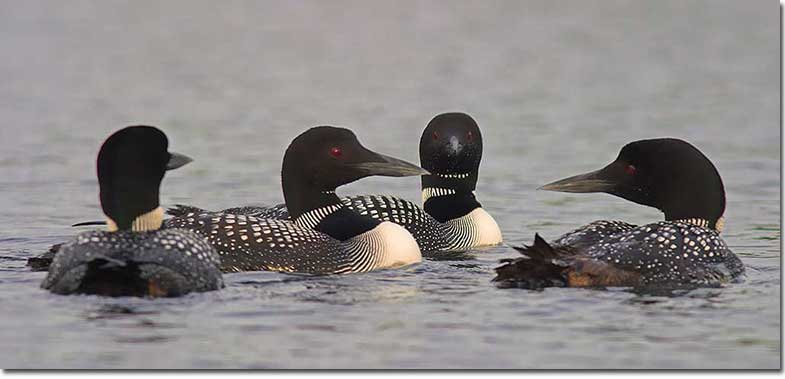
Minnesota is a big northern state with 86,935 square miles of lakes, rivers, bogs, boreal forest, prairies, and other habitats. 5,717,184 people live in the state along with a lot of birds!
More than 440 bird species have been found in Minnesota, including the official state bird, the Common Loon (Gavia immer). A big aquatic bird of summer lakes and slow, northern rivers, this species has a black head and neck band, and a black and white checkered back.
On this page
Minnesota State Bird
The Common Loon became the official state bird for Minnesota on March 13, 1961. Although most states chose official state birds in the late 1920s and 1930s, in Minnesota, choosing a state bird was postponed by indecision over which bird to pick.
For years, most Minnesotans considered the American Goldfinch to be their state bird. This beautiful little bird is common, found throughout the state, and often visits backyard feeders.
However, various other species were also proposed, and the state legislature felt there wasn’t a consensus about the avian candidate that would best represent the state.
At times, two other quintessential Minnesota birds, the Pileated Woodpecker and Belted Kingfisher, were also considered. However, after a letter-writing campaign in support of the Common Loon, the state legislature finally held an official vote to name it as the state bird 1961.
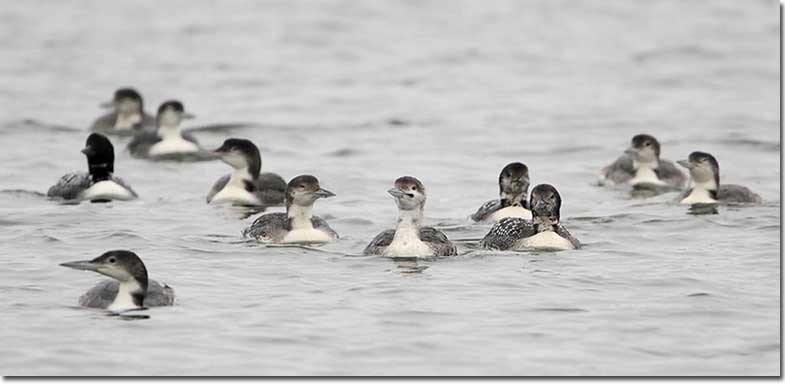
Common Loons
The Common Loon ended up being Minnesota’s state bird because this unique species is a perfect symbol of the northern forest ecosystems that dominate a fair part of the state.
Aside from Alaska, more loons live in Minnesota than any other state (12,000 loons!). Their loud, eerie yodeling calls are a standard feature of summer visits to lakes and rivers in many parts of the state.
Where can you find them?
In the summer months, Common Loons are birds of cold lakes and slow moving rivers of the north. They prefer cool, fairly deep water with healthy populations of fish, usually in forested areas.
Common Loons disappear from lakes that have low numbers of fish and also prefer waterways with little human disturbance.
Their breeding range extends from northern Michigan, Minnesota, and the Adirondacks north to much of Canada and Alaska. They also breed in coastal areas of Greenland, on Iceland, and in some parts of the northern Rocky Mountains.
The Common Loon is mostly found on waterways in forested habitats and doesn’t usually occur on the tundra. In winter, it uses coastal waters from Alaska south to Mexico, and in eastern Canada south to Florida. This species also winters on inland reservoirs in many parts of the eastern USA, and in coastal waters of Iceland and western Europe.
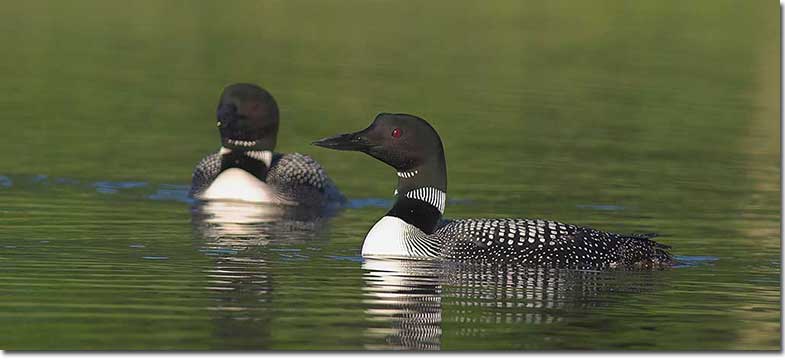
Common Loon in summer plumage
They prefer to nest on small islands, on top of floating vegetation in a bog, or other structures surrounded by water. To avoid waves affecting its nest and eggs, this species usually builds its nest on the side of an island closer to the mainland than wide open water.
They make a circular platform nest out of plant matter and build it on the ground.
Fun Facts about the Common Loon
- In Europe, Loons are called, “Divers”. Its European name is in reference to its Icelandic breeding range.
- The Common Loon and other loon species can barely walk on land. Instead, their short legs are placed far back on their body for powerful, underwater swimming.
- Loons have serious adaptations for chasing fish underwater. To enable fast diving, they have dense, heavy bones, blow air out of their lungs before diving, and flatten their feathers to make themselves more streamlined. Underwater, their heart rate also slows down to help conserve their oxygen!
- A pair of adult loons and two of their offspring can eat a half ton of fish during five weeks of foraging!
- Since a loon has to “run” on top of the water to take flight, if it lands on a small pond, the bird might not have enough room to become airborne. Unfortunately, at night and in stormy weather, they sometimes also land on wet parking lots after mistaking them for water.
- In midwinter, Common Loons molt or change all of their flight feathers. This leaves them incapable of flight for a few weeks. Luckily, they are excellent swimmers and at home on the water.
- The Common Loon has sharp features on its tongue and inside its mouth that point inward. These help it hold onto slippery fish after it catches them with its dagger-like beak.
Identification
The Common Loon is a big, heavy-bodied waterbird with a longish, tubular neck, and a sharp, dagger-like bill. They vary in size across their range but, on average, they are 32 inches long, have a five-foot wingspan, and weigh around 9 pounds.
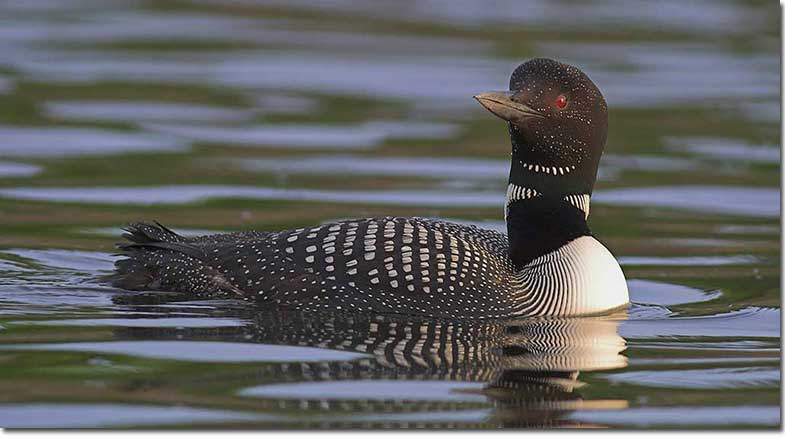
Males tend to be a little bit larger than females, although this is hard to notice in the field. In spring and summer, Common Loons have a black head and neck band, red eyes, and a black beak.
They also have fine, vertical black streaks on parts of their neck and throat. The rest of their underparts are white, and they have a bold black and white checkered pattern on most of their upperparts.
Winter adults and juveniles of this species are mostly grayish above and white below with a broken white eyering. It also has blackish on the top and tip of its grayish beak.
When flying, Common Loons, have fast direct flight on long, pointed wings. Their large feet also trail behind them.
What do Common Loons eat?
Common Loons feed on fish and some crustaceans. They can eat a wide variety of fish species but may prefer fish with erratic swimming behavior because these are easier to catch. With that in mind, Common Loons eat a lot of Yellow Perch and Bluegills.
They prefer shallow water as well as coves and other protected coastal waters. This species forages by dipping its head below the surface to look for fish and also by swimming below the water to search for fish near structures and in the water column.
When it sees a fish or crustacean, it quickly swims after it to seize the animal with its beak. They usually eat their food underwater, but if the animal is too big, they bring it to the surface.
Call
Common Loons have fantastic, loud and distinctive calls. They often make short laughter-like sounds to each other and in flight, “wuhhahahuh”. These laughter-like calls are often preceded by drawn out, mournful wailing calls.
On their breeding grounds, they also make a classic, loud series of wailing calls, “whuuuueeh,WEEEUHWEH, WEEEUHWEH, WEEEUHWEH, WEEEUHWEH”.
Although they can vocalize during the day, the mournful calls of Common Loons are made that much more eerie by the birds frequently calling during the night. Their evocative vocalizations are also frequently used in TV shows and movies.
Behavior
Except when incubating their eggs, Common Loons spend all of their time on the water. They are usually seen floating on top of calm waters before diving beneath the surface. On their breeding grounds, they usually occur in pairs or small family groups.
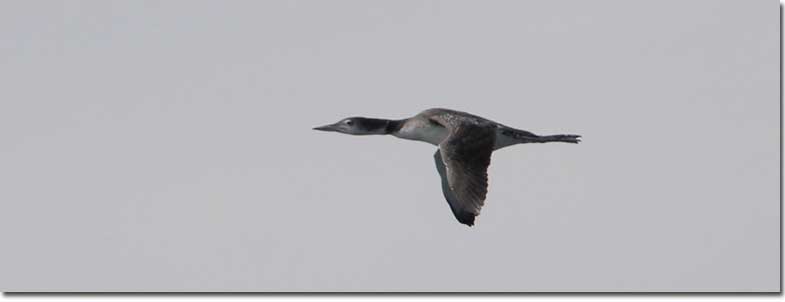
Common Loon in flight
However, on coastal coves and bays in the winter, several Common Loons can be seen in the same area. In migration, large groups of loons can also be seen in some places. On some large reservoirs, these flocks can number in the hundreds!
Common Loons don’t pose any threat to people or any pets. They defend their territories from other loons but aren’t aggressive to other birds.
Other Birds in Minnesota
Black-capped Chickadee
Black-capped Chickadees live in parks, large gardens, and woodlands throughout Minnesota. They are also frequent visitors to backyard bird feeders.
American Crow
American Crows are common birds of towns, parks, woodlands, and farmlands throughout the state. They often occur in noisy flocks that roost and forage in tall trees.
Blue Jay
The Blue Jay is a common bird of woodlands, parks, and towns throughout Minnesota. These noisy birds often flocks together and also visit feeders.
Downy Woodpecker
The Downy Woodpecker lives in parks and woodlands throughout Minnesota. They are usually seen on their own or in pairs, accompany flocks of other small birds, and are frequent visitors to bird feeders.
American Robin
American Robins live in towns, parks, farms, and woodlands throughout the state. They are often seen foraging on lawns and other open, grassy areas. In winter, they form large flocks that feed on fruiting trees and bushes.
American Goldfinch
In Minnesota, American Goldfinches are a common species of fields and second growth. Flocks also visit bird feeders and can occur in parks and towns.
White-breasted Nuthatch
The White-breasted Nuthatch lives in wooded habitats and parks throughout the state. Pairs move with other small birds and also visit feeders.
Northern Cardinal
The Northern Cardinal is a common bird of large gardens, parks, forest edge, and second growth in the southern half of Minnesota. They are usually seen in pairs and visit feeders in the morning and late afternoon.
Mallard
The Mallard is a common duck species of ponds, lakes, and most wetlands in Minnesota. They usually occur in pairs but can also form small flocks.
Canada Goose
Canada Geese are a common resident of golf courses, parks, and wetlands throughout the state. They occur as pairs and in flocks.
Keep reading – Most popular birds of Minnesota & Hawk species you can see in Minnesota
Frequently Asked Questions
What is the state bird of Minnesota?
The state bird of Minnesota is the Common Loon. Around 12,000 Common Loons live on lakes and other wetlands in this northern state.
Why is the Common Loon the state bird of Minnesota?
The Common Loon is the state bird of Minnesota because it is more common there than any of the other lower 48 states. It was also chosen to be the state bird because it is an excellent symbol and representation of the wild forests and lakes that cover the northern half of the state.
When did Minnesota choose its state bird?
Minnesota chose its state bird on March 13, 1961.
What other states have the Common Loon as their state bird?
No other states have the Common Loon as their state bird.
What was the previous state bird of Minnesota?
The previous unofficial state bird of Minnesota was the American Goldfinch.

